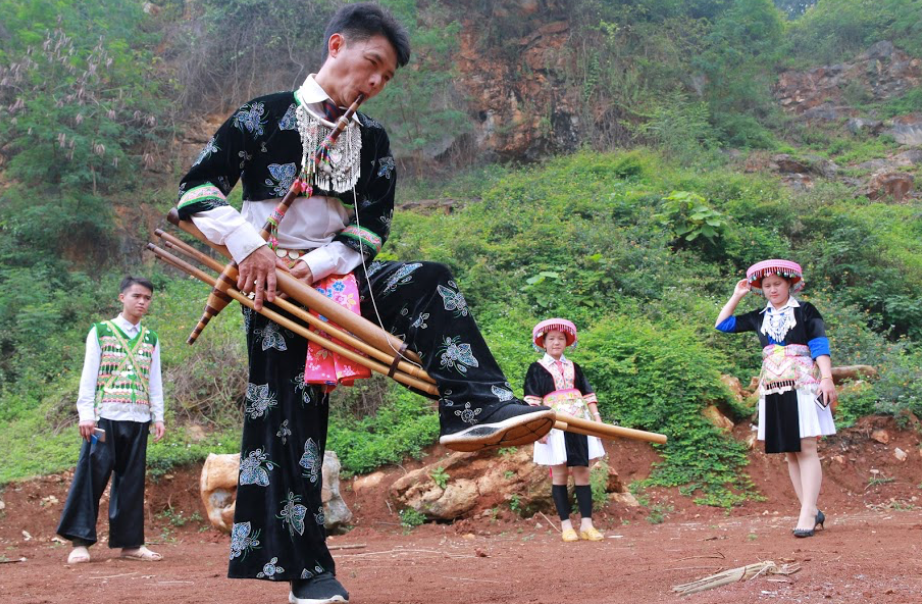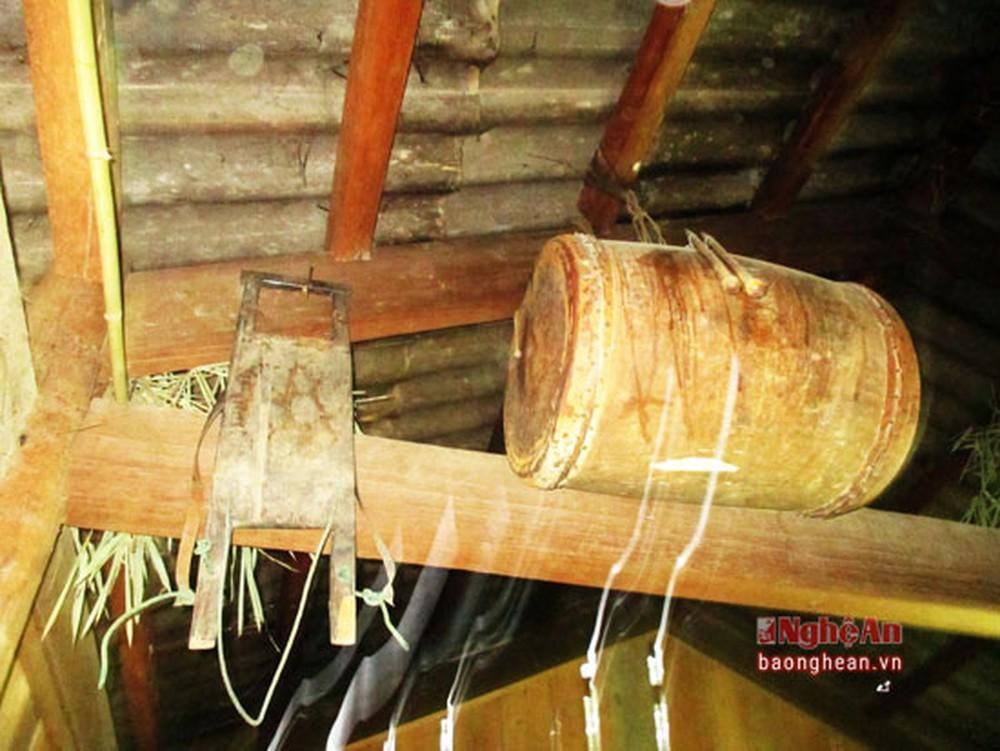Mong Instrumental Music - Part 2: Interesting Legends
(Baonghean.vn) - In the first article of the topic "Instrumental music of the Mong people", the author introduced popular musical instruments such as leaf trumpet, jaw harp (da), tra lien do (vertical flute), tra blai (horizontal flute)... In article 2, we invite readers to continue learning about other unique musical instruments of the Mong people in Nghe An, associated with interesting legends.
>> Lesson 1: Musical instruments from the great forest
Panpipes
The Khen is the most popular musical instrument of the Mong people. Knowing how to play the Khen is a criterion for girls to choose a lover, so almost every boy who reaches adulthood learns to play the Khen. If they don't have enough money to buy a Khen, they borrow from each other or practice playing it together.
 |
Spring flute sound. Photo: Dinh Tuan |
According to Mr. Va Phai Tenh - former Party Secretary of Muong Long Commune, Ky Son District, the Mong people in Nghe An have a folk tale about the flute as follows: "Once upon a time, there was a family whose mother unfortunately died, and for some unknown reason she was not buried. The 6 children loved their mother so much that they cried day and night, cried until they had no more tears, their throats were hoarse, but they could not ease their love for their mother. Someone told the 6 brothers: "If your throat is hoarse and you cannot cry, make a flute to play instead of crying." So the 6 brothers made 6 flutes to express their love for their mother and tell their children and grandchildren about their mother's merits. But playing the flute for a long time made them run out of breath, tired, and sick. One after another, they got sick; all 6 brothers could not play together to express their love for their mother. They took a dried gourd (water gourd, soup gourd), carved out 6 holes, inserted 6 flute tubes, and cut the stem of the gourd to make a mouth to blow. So they only needed One person playing the flute could still say the words of the six brothers. And after a few flute songs, as if understanding the filial piety of her children, the mother was buried so that she could go peacefully. Since then, the Mong people have a custom that when someone dies, a flute must be played so that the deceased can quickly return to their ancestors.
In Nghe An, there is also a story about a Mong man who used his panpipe to save his wife. The story says:
"Old Ba Su and Y Don were husband and wife, they lived together warmly and happily. One day, Old Ba Su went to the fields, and a tiger came and robbed Y Don's house. When he returned home, he heard the story. Old Ba Su wanted to go into the forest to find and kill the tiger to save his wife. But he knew he was weak and could not defeat the tiger; day and night he practiced martial arts, and was given a precious sword by the old people in the village. When he was strong and healthy, his sword skills were skillful, and he believed in his own strength, he went into the forest to find the tiger. With the precious sword in his hand, and the panpipe on his back, he searched from forest to forest, to this cave, that cave, every day he went, every night he rested, every night he took out his panpipe to play. He played the songs he had played for Y Don to listen to, as if recalling the time when they were passionately in love; each time like that, his legs seemed to grow stronger, his eyes seemed sharper, his ears seemed sharper.
One time while playing the flute, suddenly heard a sound like the wind playing on the leaves, looked carefully and saw that it was a tiger, he was about to swing his sword to cut, the tiger quickly spoke up and asked: "I am Y Don, your wife, the gray tiger has forced me to wear the tiger's skin. That tiger is about to return, you must be careful, it is very vicious"! Sure enough, the tiger really returned, smelling the strange meat smell, the tiger's eyes widened and jumped at Gia Ba Su, the tiger and the man fought for a long time. Encouraged by Y Don, he finally killed the ferocious tiger. But how could he take off the tiger's skin for Y Don? Feeling sorry for his wife, he took out the flute to play. The sound of the flute was passionate and loving, the more he played, the more passionate it became, like the sound of his heart in the ears of his virtuous wife. Suddenly the tiger's skin disappeared, revealing the beautiful, gentle, graceful Y Don. The couple happily brought each other back to the village. From then on, they lived together more happily and affectionately. Their children and grandchildren were as numerous as a wild beehive.
Turtle (empty)
The Mong call the drum "rua". Although drums are rarely used, they are very important in the spiritual life of the people. Drums are only played when someone dies. Some Mong families make drums for long-term use, but some families only make drums when someone dies. Drums must be made in the forest. Making drums is not too difficult for them. A hollowed-out dry tree trunk and two pieces of cowhide make a drum. People pay attention to the dry tree trunk when going to the forest or farming; every time they kill a cow, they dry the skin to save. The easier it is to make a drum, the more elaborate and complicated the procedure for welcoming the drum is. First, the drum is named. When the drum is brought home, the drum welcoming procedures are immediately carried out, including: inviting the drum's owner (chi mua), playing three flute tunes to welcome the drum (chi choi).
Only after completing the procedures can the drum be used. People do not put the drum on a rack or hang it in a convenient place, but must make a place to hang the drum. Take 3 bamboo or small pieces of wood about 3m long, tie them together, separate the 3 legs into 3 corners so that the bottom of the 3 legs is wide enough, high enough for the flute player to dance, pass back and forth under the drum and the 3 legs of the drum rack do not get in the way of the flute.
 |
The sacred drum of the Ly family in Hop Thanh village, Xa Luong commune (Tuong Duong). Photo: Huu Vi |
Blông tea, gốg tea (3-hole flute)
It is called Tra Blong because the sound when blown is like a leaf flute, resonant but clear. The head and mouth of the flute are also made like a vertical flute (tra lien do). The flute is made from a short section of bamboo.
The 3-hole flute does not have its own tune but can be played like leaf flutes and vertical flutes. Nowadays, people hardly use the 3-hole flute anymore. Is it because leaves are easy to get and can play the same content as the 3-hole flute, while the 3-hole flute requires finding bamboo and reed, which takes time and effort to make. Because of this convenience, the 3-hole flute gradually gives way to leaves? Moreover, according to some elderly people, the Mong people rarely play the 3-hole flute in the village and avoid playing it at night, so the flute is used less and less.
Divide
It is a steel circle, as big as a chopstick, with an aluminum handle or a steel ring bent and folded into the shape of a knife handle. During the ceremony, the shaman reads, chants, sings songs, and shakes the iron pieces to keep the rhythm. When raised and slammed down, the pieces of iron hit each other, creating a sound similar to playing a toothpick.
In addition to the above musical instruments, the Mong people also use bells for their livestock to easily find and identify their livestock. Notably, unlike the Mong people in the northern provinces, the Mong people in Nghe An do not use chum choe (xap xoeng) in spiritual ceremonies and do not use them in daily life.
(To be continued)

